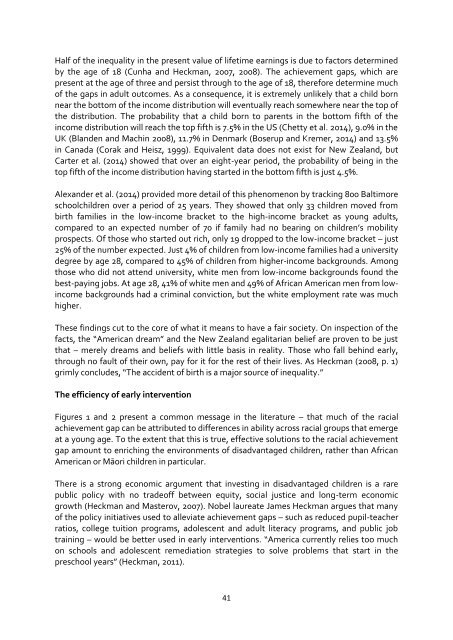UNCONSCIOUS BIAS AND EDUCATION
unconsious-bias-and-education
unconsious-bias-and-education
Create successful ePaper yourself
Turn your PDF publications into a flip-book with our unique Google optimized e-Paper software.
Half of the inequality in the present value of lifetime earnings is due to factors determined<br />
by the age of 18 (Cunha and Heckman, 2007, 2008). The achievement gaps, which are<br />
present at the age of three and persist through to the age of 18, therefore determine much<br />
of the gaps in adult outcomes. As a consequence, it is extremely unlikely that a child born<br />
near the bottom of the income distribution will eventually reach somewhere near the top of<br />
the distribution. The probability that a child born to parents in the bottom fifth of the<br />
income distribution will reach the top fifth is 7.5% in the US (Chetty et al. 2014), 9.0% in the<br />
UK (Blanden and Machin 2008), 11.7% in Denmark (Boserup and Kremer, 2014) and 13.5%<br />
in Canada (Corak and Heisz, 1999). Equivalent data does not exist for New Zealand, but<br />
Carter et al. (2014) showed that over an eight-year period, the probability of being in the<br />
top fifth of the income distribution having started in the bottom fifth is just 4.5%.<br />
Alexander et al. (2014) provided more detail of this phenomenon by tracking 800 Baltimore<br />
schoolchildren over a period of 25 years. They showed that only 33 children moved from<br />
birth families in the low-income bracket to the high-income bracket as young adults,<br />
compared to an expected number of 70 if family had no bearing on children’s mobility<br />
prospects. Of those who started out rich, only 19 dropped to the low-income bracket – just<br />
25% of the number expected. Just 4% of children from low-income families had a university<br />
degree by age 28, compared to 45% of children from higher-income backgrounds. Among<br />
those who did not attend university, white men from low-income backgrounds found the<br />
best-paying jobs. At age 28, 41% of white men and 49% of African American men from lowincome<br />
backgrounds had a criminal conviction, but the white employment rate was much<br />
higher.<br />
These findings cut to the core of what it means to have a fair society. On inspection of the<br />
facts, the “American dream” and the New Zealand egalitarian belief are proven to be just<br />
that – merely dreams and beliefs with little basis in reality. Those who fall behind early,<br />
through no fault of their own, pay for it for the rest of their lives. As Heckman (2008, p. 1)<br />
grimly concludes, “The accident of birth is a major source of inequality.”<br />
The efficiency of early intervention<br />
Figures 1 and 2 present a common message in the literature – that much of the racial<br />
achievement gap can be attributed to differences in ability across racial groups that emerge<br />
at a young age. To the extent that this is true, effective solutions to the racial achievement<br />
gap amount to enriching the environments of disadvantaged children, rather than African<br />
American or Māori children in particular.<br />
There is a strong economic argument that investing in disadvantaged children is a rare<br />
public policy with no tradeoff between equity, social justice and long-term economic<br />
growth (Heckman and Masterov, 2007). Nobel laureate James Heckman argues that many<br />
of the policy initiatives used to alleviate achievement gaps – such as reduced pupil-teacher<br />
ratios, college tuition programs, adolescent and adult literacy programs, and public job<br />
training – would be better used in early interventions. “America currently relies too much<br />
on schools and adolescent remediation strategies to solve problems that start in the<br />
preschool years” (Heckman, 2011).<br />
41


